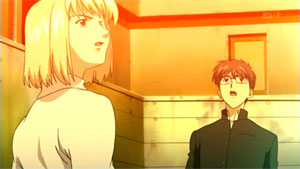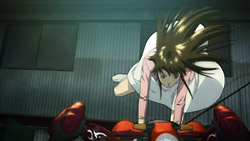 Those of you who like yuri anime may care to note that another one is appearing in the Autumn 2009 Japanese TV anime schedules - an adaptation of the popular yuri manga “Sasameki Koto”.
Those of you who like yuri anime may care to note that another one is appearing in the Autumn 2009 Japanese TV anime schedules - an adaptation of the popular yuri manga “Sasameki Koto”.
At the beginning of October I downloaded a scanlated chapter of the manga to get some idea of what it (or the anime) might be like. (There’s also a Wikipedia entry that explains plenty about it.). The anime started on 7 October 2009, and we are currently up to episode 7 or 8.
Briefly, 15-year old Sumika Murasame is academically gifted, good at sports, and skilled at karate, making her something of an alpha girl, and she is 175cm (5’9″) tall, which does nothing to diminish her reputation for being a bit scary, and she wears glasses. Secretly, she is attracted to another girl, her best friend, the pretty Ushio Kazama, who is also a lesbian. However Ushio is only attracted to cute girlies, not strapping young Amazons like Sumika.
Sumika hopes she can find a way to declare her feelings, while Ushio repeatedly pre-empts this by constantly chasing other girls, and pointing out that Sumika isn’t her type. This is (so far) a story about unrequited lesbian love – those who hope to see the other sort should look elsewhere.Â
Other characters include a cross-dressing boy who finds himself signed up as a (female) magazine model,  several other lesbians, and a yuri manga fan-girl. Inevitably, Ushio pursues the boy believing him to be a cute girl.
While this clearly isn’t another Aoi Hana, being more in the familiar territory of exaggerated romantic comedy, it does look like fun. The first anime episode, a slow one, rather misfires, and looks fairly boring in contrast to the lively opening of the manga. However it picks up from the second episode, and thereafter follows the style and storyline of the manga fairly closely. Â
In the opening scenes of episode 7, the cross-dressing boy Akemiya is bring photographed by his pushy little sister, and this scene is so sexy that it’ s really quite disturbing. Sumika is pressurised into going on a date with Akemiya, who turns up dressed as a girl. They have a snack in a cafe and then go clothes-shopping. It’s all a bit much for poor Sumika, who finds him/her so cute she practically has a nosebleed. Crikey. Don’t watch this episode, guys, if you’re worried about being turned gay.
This series shows the potential of yuri romantic anime for comedy; however there’s as much drama as comedy. As a drama it has a problem in that the humour lies in Ushio never realising that Sumika fancies her, and so the same cycle of Sumika’a hope and disappointment is spun out indefinitely. If Ushio got the message, the story would either end or morph into something else.
By the way, one is aware that successive generations of Japanese are getting taller, apparently because of improved diet, so Sumika’s height may not that unusual. Still, at 5ft 9in she’d be a tall girl in any country!

 Fumi (Aoi Hana)
Fumi (Aoi Hana)  Fumi
Fumi Just finished watching Tekkonkinkreet. Another neglected masterpiece! Unusually, it is directed by an American, Michael Arias, who was also involved with “Animatrix” etc. Less unusually, it has a sound-track by two British musicians. Having seen it, I have to say that perhaps Western direction is what anime needs to drag it out of the mediocricy into which it seems to be sinking.
Just finished watching Tekkonkinkreet. Another neglected masterpiece! Unusually, it is directed by an American, Michael Arias, who was also involved with “Animatrix” etc. Less unusually, it has a sound-track by two British musicians. Having seen it, I have to say that perhaps Western direction is what anime needs to drag it out of the mediocricy into which it seems to be sinking. Just finished watching “A Tree of Palme”. I bought it because I remembered seeing it reviewed as being very good but neglected. I had an idea it was some fey period drama, but this turned out to be completely wrong! It’s set in a totally imagined fantasy world – cue major weirdness… If you remember the “Kaiba” TV series, it’s a bit like that. As this is the only anime it resembles in the slightest, it will be interesting to find out if there is any connection. The designs are beautiful. And Palme is a wooden puppet.
Just finished watching “A Tree of Palme”. I bought it because I remembered seeing it reviewed as being very good but neglected. I had an idea it was some fey period drama, but this turned out to be completely wrong! It’s set in a totally imagined fantasy world – cue major weirdness… If you remember the “Kaiba” TV series, it’s a bit like that. As this is the only anime it resembles in the slightest, it will be interesting to find out if there is any connection. The designs are beautiful. And Palme is a wooden puppet. Kuniyoshi exhibition of 19th century Japanese prints, Royal Academy, London.
Kuniyoshi exhibition of 19th century Japanese prints, Royal Academy, London. I pulled this off the shelf at random to watch again. It’s a 12-episode TV series from 2003, later made available in the US by Geneon, and there is also a related movie (or OVA) series “Kara no Kyoukai” from 2007.
I pulled this off the shelf at random to watch again. It’s a 12-episode TV series from 2003, later made available in the US by Geneon, and there is also a related movie (or OVA) series “Kara no Kyoukai” from 2007.